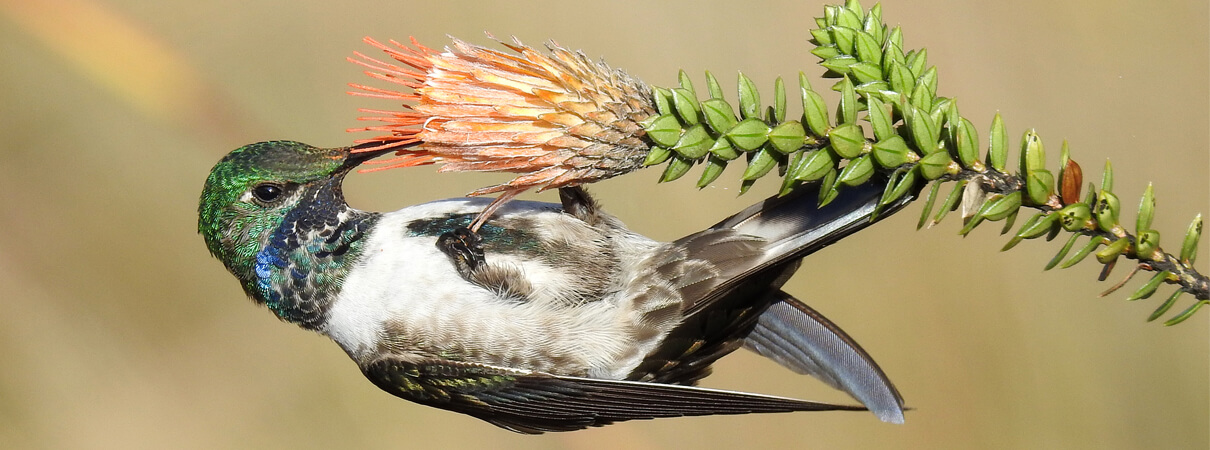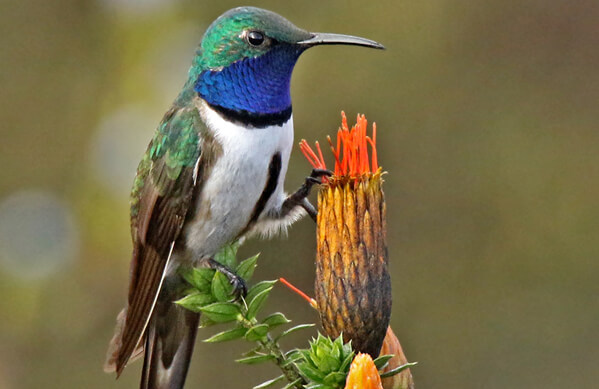
Blue-throated Hillstar range map, Birds of North America, https://birdsna.org, maintained by the Cornell Lab of Ornithology
The beautiful Blue-throated Hillstar was discovered in 2017 and officially described a year later. It's only found on a few mountains in southwestern Ecuador, particularly the Cerro de Arcos (“Hill of Arches”). At over 12,000 feet, the hillstar's windswept habitat, known as páramo, is a unique ecosystem of boggy grass and shrublands, studded with evergreen plants, mosses, and cacti.
Like other high-elevation hummingbirds, such as the Rainbow-bearded Thornbill and Glittering Starfrontlet, the Blue-throated Hillstar manages to thrive in a cold, oxygen-reduced environment.
Hummers with Altitude
How do these hummingbirds survive in such harsh conditions? Found only in open habitats of the Andes, the Blue-throated Hillstar and others of its genus are adapted for the high life. These birds have physical and behavioral adaptations that allow them to survive and thrive in cold, oxygen-poor surroundings.
Researchers recently discovered that some highland hummingbird species, including hillstars, have hemoglobin — the protein responsible for transporting oxygen in the blood — with high oxygen-binding capabilities. This adaptation allows the birds to make the most of available oxygen.
Thin air makes hovering less efficient, so the hillstars tend to feed while clinging to or perching next to flowers. In general, these birds also spend a lot of time perched, saving energy for when flight is needed. At night, like others of its genus, the Blue-throated Hillstar probably roosts in crevices, where it enters a state of low metabolism known as torpor, when its normally high daytime metabolic rate drops and its heart rate slows to a crawl. Many other birds, including the Black-capped Chickadee, use this survival strategy to conserve energy in cold conditions.
Feeding from the Flower of True Love
The Blue-throated Hillstar favors nectar from Chuquiraga jussieu — known locally as the Chuquiragua — a low-growing evergreen shrub with spiky leaves and small pine-cone-like orange flowers. While reaching to sip nectar, the hillstar clambers over the plant, clinging to its branches and flowers sideways or even upside down, somewhat like a chickadee. The Blue-throated Hillstar feeds at other plants as well and has been seen making short aerial sallies to snap up flies.
However, the Chuquiragua, also called the “national flower of Andean mountain climbers” and the “flower of true love,” is the Blue-throated Hillstar's main food source, and the bird is this plant's main pollinator. This interdependence means that the two species' fates are inextricably tied. Due to widespread habitat loss and degradation, Chuquiragua has been disappearing across its range in the mountains of Ecuador (and also in Colombia and Peru), so restoring patches of Chuquiragua is key to conserving this highly localized mountain hummingbird.

Blue-throated Hillstar feeding at Chuquiragua flower, Cerro de Arcos, by Michael Moens
Habitat Lows in the Highlands
In addition to habitat loss resulting from expanding farms and ranches, including pine plantations, the Blue-throated Hillstar's páramo home is threatened by gold mining.
After the Blue-throated Hillstar's 2017 discovery, ABC and Ecuadorian partner Fundación Jocotoco began to raise funds to buy 616 acres of habitat around Cerro de Arcos, where the largest known population of the species is found. This project's long-term goals include protecting a total 1,235 acres, restoring Chuquiragua patches, and promoting birding tourism, as this site lies between Buenaventura and Yunguilla, two other popular Jocotoco reserves. These reserves protect other threatened birds such as the El Oro Parakeet and Pale-headed Brushfinch. (More information about visiting ABC-supported reserves in Ecuador can be found on the Conservation Birding website.)
ABC and Fundación Jocotoco hope to monitor additional hillstar sites and set up an educational campaign for local school children, focused on the species and páramo conservation.
Identified as a "gap" species, the Blue-throated Hillstar currently lacks protected habitat and will likely go extinct without prompt conservation action. For the same reason, this recently described species also features on ABC's list of 50 flagship species.
Donate to support ABC's conservation mission!



















































